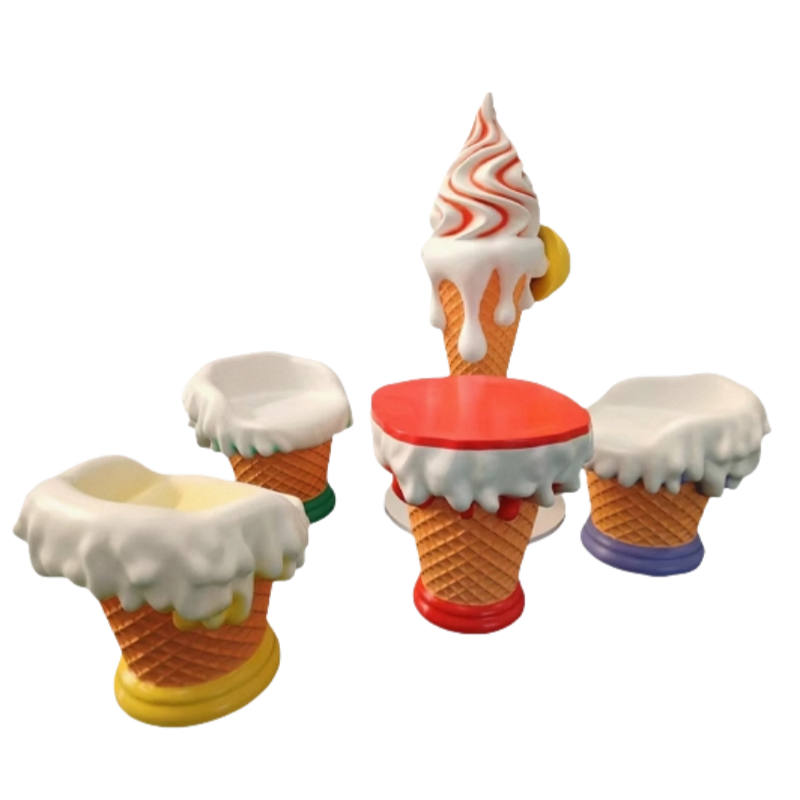El atractivo duradero de la escultura de fibra de vidrio
Escultura de fibra de vidrio ofrece una combinación atractiva de durabilidad, flexibilidad de diseño y practicidad que la convierte en una excelente opción para la decoración del hogar. Los propietarios que buscan una pieza destacada que pueda resistir la exposición ligera al exterior, la humedad interior y mantenerse visualmente atractiva durante años, encontrarán en la escultura de fibra de vidrio una opción convincente. Desde figuras contemporáneas audaces en un salón hasta formas botánicas sutiles en una terraza, la escultura de fibra de vidrio se adapta a la escala, el acabado y la colocación de formas que muchos medios tradicionales no pueden igualar. Su capacidad para imitar otras texturas manteniéndose ligera brinda a decoradores y arquitectos una libertad poco común. Ya sea para crear un punto focal, definir una secuencia de entrada o incorporar un toque artístico en un apartamento urbano pequeño, la escultura de fibra de vidrio ofrece opciones que son simultáneamente táctiles, resistentes y asequibles en comparación con alternativas pesadas como la piedra o el metal fundido.
Versatilidad de diseño y rango estilístico
Libertad de forma y escala con escultura de fibra de vidrio
Escultura de fibra de vidrio destaca porque se puede moldear en prácticamente cualquier forma y se puede terminar para que parezca piedra, bronce, madera o arte moderno pintado. Los diseñadores pueden encargar una figura humana a tamaño real, un diseño abstracto en espiral para un vestíbulo o un racimo botánico delicado a escala para un balcón. La maleabilidad del fibra de vidrio permite detalles finos en rasgos faciales o gestos arquitectónicos grandes y fluidos dentro del mismo proceso de producción. Esta flexibilidad hace que la escultura de fibra de vidrio sea una opción favorita cuando los propietarios o equipos creativos desean un ambiente preciso o una escala personalizada que no es posible lograr con decoración prefabricada.
Acabados y tratamientos superficiales para cada interior
Una de las fortalezas de la escultura de fibra de vidrio es la forma en que puede aceptar tratamientos superficiales de manera convincente. Con imprimantes y recubrimientos adecuados, la escultura de fibra de vidrio puede terminarse para parecer bronce pulido, pátina envejecida, mármol pulido o pintura contemporánea vibrante. Esto significa que el propietario puede hacer que la escultura combine con armarios, azulejos o paletas de textiles existentes, sin tener que comprometerse con el peso y el costo de bronce o piedra auténticos. Además, los recubrimientos de grado exterior permiten que las esculturas de fibra de vidrio mantengan su acabado durante años cuando se utilizan en patios semi-cubiertos.
Compatibilidad con iluminación e instalaciones de materiales mixtos
Las obras de escultura en fibra de vidrio funcionan maravillosamente en esquemas de materiales mixtos. Responden bien al iluminación ascendente dramática, al suave resplandor lateral y a los acentos integrados de LED. En islas de cocina, solárium y vestíbulos de doble altura, la escultura en fibra de vidrio se convierte en una superficie para la luz, proyectando sombras superpuestas y realzando las texturas. Su reducido peso también facilita la instalación de hardware de suspensión o soportes de pedestal, ampliando las opciones de colocación para elementos escultóricos dentro de una vivienda.
Durabilidad, mantenimiento y longevidad
Resistencia climática y adecuación para exteriores de la escultura en fibra de vidrio
La escultura de fibra de vidrio está diseñada para resistir la humedad y la variabilidad de temperatura mucho mejor que muchas alternativas compuestas. Aunque no es impermeable a condiciones extremas sin un acabado adecuado, una escultura bien construida de fibra de vidrio con recubrimientos superiores estables ante los UV y fijaciones resistentes a la corrosión mantendrá su integridad estructural en exteriores, en decks, terrazas o en nichos de jardín. Para propietarios que buscan adornos de jardín que requieran menos ingeniería pesada que la piedra, la escultura de fibra de vidrio ofrece un atractivo equilibrio.
Bajo mantenimiento y rutinas de limpieza sencillas
Otra ventaja de la escultura de fibra de vidrio es el mínimo mantenimiento que requiere. La limpieza rutinaria suele necesitar únicamente un paño suave, detergente suave y enjuagues ocasionales. Debido a que el sustrato no se corroe, no se pudre ni se deforma como la madera sin tratar o algunos metales, el presupuesto de mantenimiento a largo plazo es menor. Las ceras protectoras y la renovación periódica del sellador prolongan la vida útil del acabado en instalaciones al aire libre. Para piezas interiores, quitar el polvo y lavados suaves ocasionales suelen ser suficientes para mantener la escultura de fibra de vidrio con apariencia nueva.
Resistencia a plagas y degradación biológica
A diferencia de los materiales orgánicos que pueden atraer plagas o deteriorarse con la humedad, la escultura de fibra de vidrio no proporciona alimento para insectos y no favorece el crecimiento de moho cuando está adecuadamente sellada. Esta resistencia biológica hace que las esculturas de fibra de vidrio sean especialmente prácticas para climas húmedos o viviendas con ventilación variable, donde mantener materiales orgánicos en perfecto estado sería más difícil.
Ventajas prácticas en la instalación y uso doméstico
Construcción ligera e instalación simplificada
Una de las ventajas más prácticas de la escultura de fibra de vidrio es su bajo peso en relación con su tamaño. Formas grandes que requerirían equipo pesado si fueran de piedra pueden ser manipuladas y posicionadas por un pequeño equipo cuando están hechas de fibra de vidrio. Esto reduce la complejidad de la instalación, permite una colocación creativa en escaleras interiores estrechas o terrazas en la azotea, y disminuye los costos de entrega y de refuerzo estructural. Para los propietarios que desean piezas llamativas y de gran tamaño sin los inconvenientes logísticos, la escultura de fibra de vidrio es una solución inteligente.
Ensamble modular y transportabilidad de las piezas de fibra de vidrio
Muchas esculturas de fibra de vidrio se producen en secciones que se unen con tornillos, lo que hace posible el transporte hacia apartamentos o a través de portones de jardín estrechos. Esta modularidad también simplifica las reparaciones y actualizaciones: se pueden reemplazar o retocar paneles individuales sin mover toda la obra. Este enfoque de ensamblaje prolonga la vida y la flexibilidad de la escultura de fibra de vidrio en entornos domésticos cambiantes.
Seguridad y tolerancia al impacto en hogares habitados
La escultura de fibra de vidrio tiene una tolerancia al impacto que le permite resistir golpes ocasionales, mascotas juguetonas o pequeños choques con muebles. En comparación con cerámicas frágiles o arte en vidrio soplado delicado, la escultura de fibra de vidrio soporta con mayor elegancia las realidades de la vida cotidiana, lo que la hace compatible con hogares familiares y áreas de uso activo.

Rentabilidad y potencial de personalización
Precios competitivos y propuesta de valor para los propietarios de viviendas
Al equilibrar presupuesto, impacto estético y durabilidad, la escultura de fibra de vidrio suele ofrecer un valor superior. El costo por impacto visual puede ser menor en comparación con piedra tallada o bronce fundido, manteniendo aún una apariencia de lujo. Esta asequibilidad abre posibilidades para clientes que desean una o varias obras destacadas sin la misma inversión de capital que requieren los materiales tradicionales.
Opciones personalizadas y colaboración artística con creadores
Debido a que la escultura de fibra de vidrio puede moldearse a partir de patrones y moldes personalizados, los propietarios pueden colaborar con artistas para producir piezas verdaderamente únicas. Los clientes pueden comenzar desde bocetos, modelos 3D o modificar un prototipo del estudio del artista para adaptarlo a paletas de colores y restricciones de tamaño. Ese camino personalizado permite al propietario encargar una escultura de fibra de vidrio exclusiva para su hogar, reflejando personalidad e intención de diseño.
Resistencia a la depreciación y longevidad estética
Una escultura de fibra de vidrio bien seleccionada mantiene su valor estético con el tiempo. A diferencia de la decoración orientada por tendencias que rápidamente se desactualizan, una pieza escultórica cuidadosamente diseñada, especialmente si está personalizada, puede permanecer como una característica distintiva de la propiedad durante años, apoyando narrativas de reventa y mejorando la fotografía interior para las listas.
Impacto estético y enfoques curatoriales
Creación de puntos focales y anclajes visuales con esculturas de fibra de vidrio
La escultura de fibra de vidrio es especialmente eficaz para crear puntos focales en las habitaciones. Una obra figurativa audaz cerca de la entrada, una forma abstracta en una esquina iluminada por el sol, o una pieza lineal que se extiende a lo largo de un pasillo pueden anclar la distribución del mobiliario y definir las líneas visuales. Estos anclajes ayudan a los visitantes a comprender la circulación dentro de una vivienda y las prioridades visuales del propietario.
Combinación de esculturas con textiles, alfombras y plantas
La creación artística con fibra de vidrio implica equilibrar texturas duras y suaves. Coloque una escultura de fibra de vidrio con alto brillo frente a asientos de lino, o sitúe una escultura mate con apariencia de piedra junto a plantas en macetas para resaltar el contraste natural. Debido a que la fibra de vidrio puede emular diversos materiales, se integra fácilmente en paletas de diseño superpuestas.
Rotación estacional y temática de acentos escultóricos
Gracias a su portabilidad y a la variedad de acabados, los propietarios pueden rotar elementos escultóricos de fibra de vidrio según la temporada o evento. Acabados más claros y brillantes en verano y tonos más ricos y patinados en invierno renuevan el ambiente del hogar sin necesidad de comprar piezas nuevas. Esta flexibilidad curatorial mantiene los interiores dinámicos y bien pensados.
Sostenibilidad y Consideraciones Ambientales
Huella de materiales y avances en fabricación
Aunque la fibra de vidrio es un compuesto derivado del petróleo, avances en la química de resinas, el uso de fibra de vidrio reciclada y recubrimientos superiores más duraderos han mejorado el perfil ambiental de la escultura moderna de fibra de vidrio. La durabilidad reduce la frecuencia de reemplazo, y algunos fabricantes ahora ofrecen productos con resinas de menores emisiones y contenido de fibra de vidrio recuperada. Elegir acabados de larga vida y evitar repintados frecuentes minimiza el carbono incorporado durante la vida útil de una pieza.
Vías de reutilización, reparación y reciclaje
La escultura de fibra de vidrio es a menudo reparable: grietas o daños superficiales pueden ser rellenados y refinidos sin necesidad de reemplazarla por completo. Al final de su vida útil, procesos especializados de reciclaje pueden recuperar las fibras de vidrio de los compuestos, aunque la disponibilidad local varía. Para propietarios preocupados por la circularidad, seleccionar piezas diseñadas para ser reparadas y con planes documentados para el final de su vida útil ayuda a hacer que la escultura de fibra de vidrio sea una opción más responsable.
Certificaciones y prácticas de sourcing responsables
Estudios y galerías de renombre documentarán el origen de los materiales, el contenido de COV en los acabados y el mantenimiento recomendado para limitar el impacto ambiental. Consultar sobre estas prácticas brinda a los compradores una visión más clara de la huella de una escultura de fibra de vidrio y alinea las adquisiciones con los objetivos de sostenibilidad.
Orientación sobre colocación y consejos de estilo para propietarios de viviendas
Elegir la escala y proporción adecuadas para los espacios
Seleccionar la escala correcta para una escultura de fibra de vidrio es fundamental. En habitaciones pequeñas, elija estatuas con énfasis vertical que complementen la altura del techo; en espacios de planta abierta, utilice piezas horizontales más grandes para delimitar zonas de comedor y asientos. El equilibrio visual es importante: una pieza demasiado grande abruma, mientras que una demasiado pequeña puede sentirse perdida.
Selección de pedestales, soportes y hardware de integración
La base adecuada eleva una obra de arte y protege los pisos. Los zócalos bajos, soportes para pared o anclajes integrados diseñados para esculturas de fibra de vidrio proporcionan estabilidad sin dominar la forma. Utilice almohadillas antideslizantes y considere consultar a un estructurista para instalaciones más pesadas, asegurando la seguridad a largo plazo.
Armonizando con paletas de colores y esquemas de texturas
Dado que las esculturas de fibra de vidrio pueden imitar múltiples acabados, combine intencionadamente texturas para crear efectos deseados. Una habitación monocromática se beneficia de un acento escultórico con textura, mientras que los interiores eclécticos ganan cohesión al repetir un color escultórico en los textiles del espacio.
Cuidado, restauración y preservación a largo plazo
Prácticas rutinarias de conservación para diferentes acabados
Acabados diferentes requieren cuidados diferentes: las superficies pintadas toleran jabón suave y esponjas blandas, mientras que los recubrimientos con aspecto metálico pueden necesitar pulido con microfibra. Evite limpiadores abrasivos y lavados a alta presión en patinas delicadas. La inspección regular de sellos y fijaciones ayuda a detectar problemas temprano.
Opciones profesionales de restauración para piezas antiguas
Cuando una escultura de fibra de vidrio está dañada, conservadores experimentados pueden volver a unir las roturas, reemplazar elementos faltantes y reaplicar recubrimientos con color coincidente. Debido a que muchas esculturas de fibra de vidrio son modulares, las restauraciones a menudo pueden ser localizadas, reduciendo costos y tiempo de inactividad.
Seguro y documentación para obras valiosas
Documente la procedencia, fotografías y registros de mantenimiento. Asegurar adquisiciones escultóricas significativas protege a los propietarios contra daños accidentales y robo. Un informe profesional del estado establece una documentación básica para futuros cuidados o reventa.
Preguntas frecuentes
Consideraciones de Durabilidad y Mantenimiento
La escultura de fibra de vidrio es duradera y requiere un mantenimiento mínimo. El polvo debe eliminarse regularmente y ocasionalmente se puede lavar suavemente para preservar su acabado. Para piezas exteriores, aplique recubrimientos estables a los rayos UV y planifique la renovación periódica de selladores para prolongar su vida útil.
Adecuado para colocación en interiores y exteriores
Las esculturas de fibra de vidrio funcionan bien tanto en interiores como en entornos exteriores semi protegidos. Con un acabado y anclaje adecuados, tolera entornos como patios y terrazas, aunque la exposición prolongada y directa a climas extremos debe mitigarse con recubrimientos protectores o techado.
Personalización y proceso de encargo
Encargar una escultura de fibra de vidrio generalmente implica bocetos conceptuales, maquetas a escala y una etapa final de prototipo. La naturaleza modular del proceso de fabricación hace viable la producción de obras grandes, y los acabados pueden personalizarse para hacer juego con el diseño interior.
Impacto ambiental y posibilidad de reparación
Aunque la fibra de vidrio es un material compuesto, su construcción duradera y posibilidad de reparación reducen el impacto del ciclo de vida. Consulte a los fabricantes sobre contenido reciclado, resinas de bajo contenido de COV y opciones de reparación para tomar decisiones más sostenibles.
Tabla de Contenido
- El atractivo duradero de la escultura de fibra de vidrio
- Versatilidad de diseño y rango estilístico
- Durabilidad, mantenimiento y longevidad
- Ventajas prácticas en la instalación y uso doméstico
- Rentabilidad y potencial de personalización
- Impacto estético y enfoques curatoriales
- Sostenibilidad y Consideraciones Ambientales
- Orientación sobre colocación y consejos de estilo para propietarios de viviendas
- Cuidado, restauración y preservación a largo plazo
- Preguntas frecuentes


